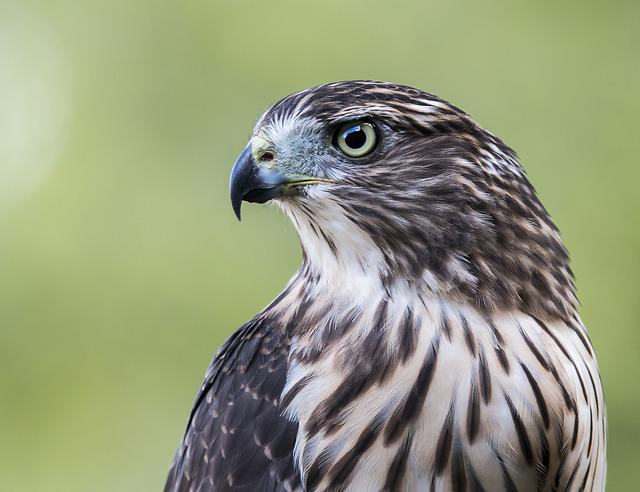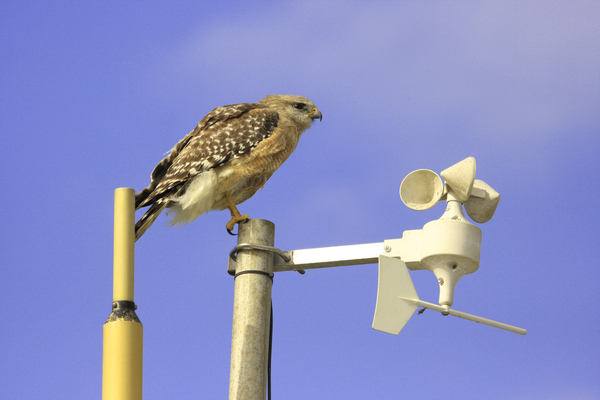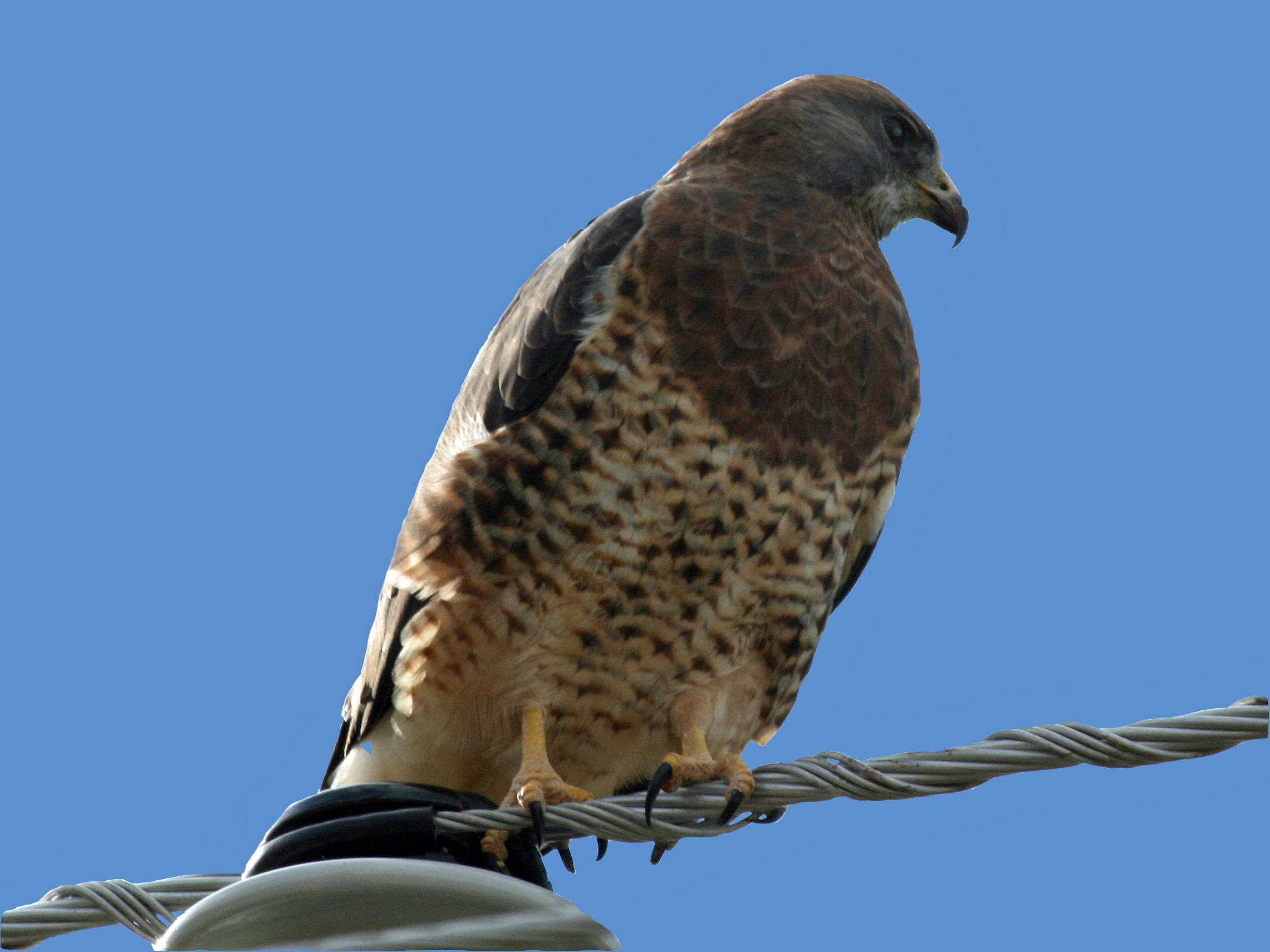Wisconsin is home to a diverse range of hawks, each with unique characteristics and behaviors.
In this article, we will explore the 8 types of hawks found in Wisconsin, including their physical traits, habitats, and hunting strategies.
Whether you’re an avid birdwatcher or simply curious about the wildlife in your area, this guide will provide an informative introduction to the hawks of Wisconsin.
| Image | Name |
|---|---|
 | Red-Tailed Hawk |
 | Sharp-Shinned Hawks |
 | Cooper's Hawk |
 | Northern Goshawk |
 | Red-shouldered Hawk |
 | Rough-legged Hawk |
 | Broad-Winged Hawk |
 | Swainson's Hawks |
Types of Hawks in Wisconsin
1. Red-Tailed Hawk

Many Wisconsinites have seen and been acquainted with this widespread species.
Furthermore, the Red-Tailed Hawk is the second-largest hawk in the Americas.
The crimson tails and white tummies of this species are easily recognizable.
The feathers of these birds may range from almost black to nearly white, with the exception of the tail.
Because of this, their upper bodies look the same as those of other hawk species, so you have to rely on the color of their tails to tell them apart.
You’ll often find these lonely birds perched on telephone wires, wooden posts, the boundaries of open areas, or lonely trees, while they are known to make their homes in a wide variety of habitats, from the open land to dense woods.
Since Red-tailed hawks appear to be at home in a wide variety of environments, it’s difficult to link them to a specific habitat.
Intriguingly, Red-Tailed Hawks are the supposed models for the bald eagle calls you hear in so many Hollywood productions.
Mice, ground squirrels, rats, and voles make up the majority of these birds’ diets, but you can also see them snacking on carrion or even snakes.
Although Red-Tailed Hawks may be seen across Wisconsin throughout the year, the best times to do so are in the summer and winter months.
These birds may also be seen often in the early morning, just before they begin their foraging for the day.
2. Sharp-Shinned Hawk

You won’t find a more agile or nimble hawk species across Wisconsin than these little guys.
The female Sharp-Shinned Hawks are typically a third bigger than the males, which is an intriguing fact about this species.
When in flight, the wings of these hawks seem small and rounded, while the tail seems bigger.
When courting, male and female Sharp-Shinned Hawks are typically seen soaring in a circling pattern.
The upper parts of these birds are typically brown, while the underparts are white.
Sharp-Shinned Hawks often nest on low-hanging branches inside thick woodlands.
The harsh screech and “kiik-kiik-kiik” sounds that these birds make are distinctive.
Usually, the best places to see these avian residents are near bird feeders or in dense forests.
In during months of June and August, before they move south during September, they are readily seen.
A Sharp-Shinned Hawk breeding is best seen in the summer, July, and August months.
These birds were most often seen in the northern woods and pine wetlands of Wisconsin.
3. Cooper’s Hawk

Do not depend too much on hearing the calls of this hawk species; they are notoriously quiet.
Like the Sharp-Shinned Hawk, the female Cooper’s hawk is often larger than the male.
These birds are most often seen in Wisconsin’s forests and around the fringes of farmlands.
Cooper’s Hawks are often bluish-gray in hue, with rusty breasts.
The distinctive “kuck-kuck-kuck” of these birds serves as a warning call.
Cooper’s Hawks may be seen practically year-round, much like Red-tailed Hawks, although they do not reproduce in Wisconsin. That’s why they make the annual trek north.
However, October is the greatest time to see these hawks since that is when they go south for the winter.
It’s possible that the ideal time of day to see the Cooper’s Hawks might also affect where you’re most likely to see them.
Northern locations are the best option for seeing them in the summertime, while the autumn regions are the best bet for seeing them in the cold season.
4. Northern Goshawk

Among raptors, the Northern Goshawk is notoriously elusive.
Big, dense woods are their preferred habitat.
Because of its black head and piercing red eyes, the Northern Goshawk stands out among other hawks.
These hawks in Wisconsin are quite cautious of their nests, so it’s better to observe them from a range if you want to tell them apart from other species.
These hawks also make a “kii-kiii-ki” sound, which serves as an alert when danger is around.
Some Northern Goshawks have bluish-white underbellies, whereas others are a pale gray with striping.
The Northern Goshawk is more likely to be seen across Wisconsin’s northern areas.
The summertime is the optimum time to see these birds since that is when they migrate north to make their nests.
5. Red-shouldered Hawk

These hawks have some of the brightest vibrant plumage of any Wisconsin hawk species, making it impossible to confuse them with any other kind.
Their upper bodies are striped with rufous, their underwings are predominantly white, and their tails are boldly banded.
The crimson shoulders that give these birds their name are most noticeable when they are perched.
Red-shouldered hawks make a unique cry that may be characterized as ‘keee-aah,’ with the first pitch being extremely high and the different note being really low.
It’s also important to remember that perhaps the Red-Shouldered Hawk is listed as an endangered species in the Conservation Plan.
These birds may be found all around the state of Wisconsin, although they are notoriously difficult to identify.
They like to nest on trees near water, so you’ll have the most luck seeing them in riverine regions.
These birds like to spend the winter in Wisconsin, so March and April are the ideal months to try to find them there.
6. Rough-legged Hawk

These birds, which are found under the names Rough-Legged Buzzard and Rough-Legged Falcon, are very uncommon across Wisconsin since they pass the summertime on the Arctic tundra.
In Wisconsin, you’re more likely to see these birds during the fall months of August and October as they make their annual migration south for the winter.
Rough-legged hawks typically have black bellies, white faces, and dark wingtips.
These birds are well-known for the meticulous care they take while constructing their nests.
This is due to the nests they build being so large and clumsily constructed from sticks and even bones.
These birds are so covert that they may only be seen first thing in the morning.
It is not uncommon to see Rough-Legged Hawks in wide agricultural fields or around United States airports as they go about their migratory patterns.
Waushara County is the finest site across Wisconsin to see Rough-Legged Hawks.
7. Broad-Winged Hawk

These birds are well-suited to their woodland habitat due to their low stature and stocky build.
Although Broad-Winged Hawks may be found across the state of Wisconsin, sightings of these birds are quite rare.
This is due to they prefer to spend their time in remote areas of the forest, far from civilization.
In Wisconsin, Broad-Winged Hawks draw crowds every autumn for their remarkable migratory journey.
The Broad-Winged Hawk migrates in large groups, unlike most other hawk species.
The most intriguing aspect of their migration is the fact that they may cover over 4500 miles in a single direction and that they frequently make these journeys twice yearly.
The northern regions of Wisconsin are the most likely to have sightings of the Broad-Winged Hawk, which builds its nests in dense woods and along forest margins.
These hawks have occasionally been reported as far south as Wisconsin, although they are more often found in the state’s more heavily wooded regions.
Even though these birds are often observed across Wisconsin during the summertime, they never spend the winter there.
8. Swainson’s Hawk

The large wings and short tails of these hawks are a defining feature of the species.
The wings among most Swainson’s Hawks are coated in black plumage, while their belly is covered in white plumage.
However, it’s worth noting that the birds may exhibit a wide range of coloration based on the environment in which they are used.
Swainson’s hawks spend the majority of their summers out in the field, and their nests are frequently located in grassy areas.
They often wait for their meal while sitting high in very tall trees.
During their October migration through Wisconsin, you may clearly recognize these birds.
Conclusion
In conclusion, Wisconsin is a remarkable place for bird enthusiasts, particularly those interested in observing hawks in their natural habitats.
With eight distinct types of hawks found in the state, there is always something new to learn and discover.
From the fierce and powerful Red-tailed Hawk to the agile and quick Cooper’s Hawk, each species offers a unique glimpse into the fascinating world of raptors.
Whether you’re a seasoned birder or just starting out, exploring the diverse hawks of Wisconsin is a rewarding and unforgettable experience.
So grab your binoculars and head outside – you never know what you might find!
FAQ
Are there any endangered species of hawks in Wisconsin?
Yes, the Ferruginous Hawk and the Northern Harrier are both listed as endangered species in Wisconsin. These hawks face threats such as habitat loss and pesticide use, which have caused their populations to decline.
What is the largest type of hawk found in Wisconsin?
The largest type of hawk found in Wisconsin is the Rough-legged Hawk. These birds have a wingspan of up to 55 inches and can weigh up to 3 pounds.
Do all types of hawks in Wisconsin migrate?
No, not all types of hawks in Wisconsin migrate. Some, such as the Red-tailed Hawk, are year-round residents, while others, such as the Broad-winged Hawk, migrate to Central and South America during the winter.
Are hawks dangerous to humans?
Generally, hawks are not considered dangerous to humans. They are shy and elusive creatures that prefer to avoid human interaction. However, it is important to give these birds of prey their space and not disturb their nesting sites.
What is the hunting strategy of hawks?
Hawks are skilled hunters that use a variety of strategies to catch their prey. Some, like the Cooper’s Hawk, rely on stealth and surprise to catch birds in flight, while others, like the Red-tailed Hawk, use their powerful talons to catch small mammals on the ground.
Last Updated on April 6, 2023 by Lily Aldrin
